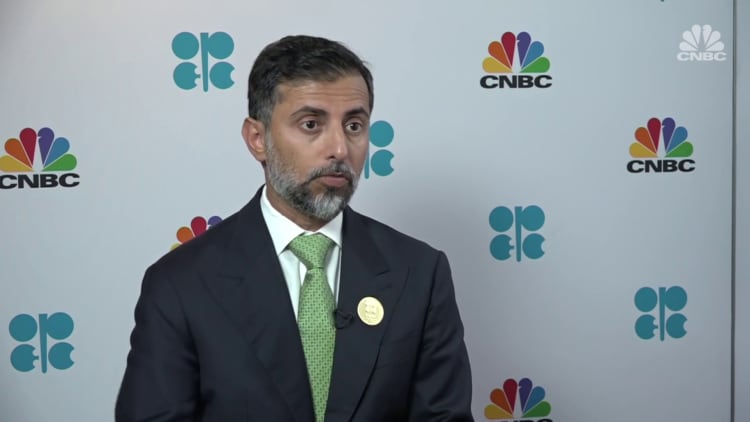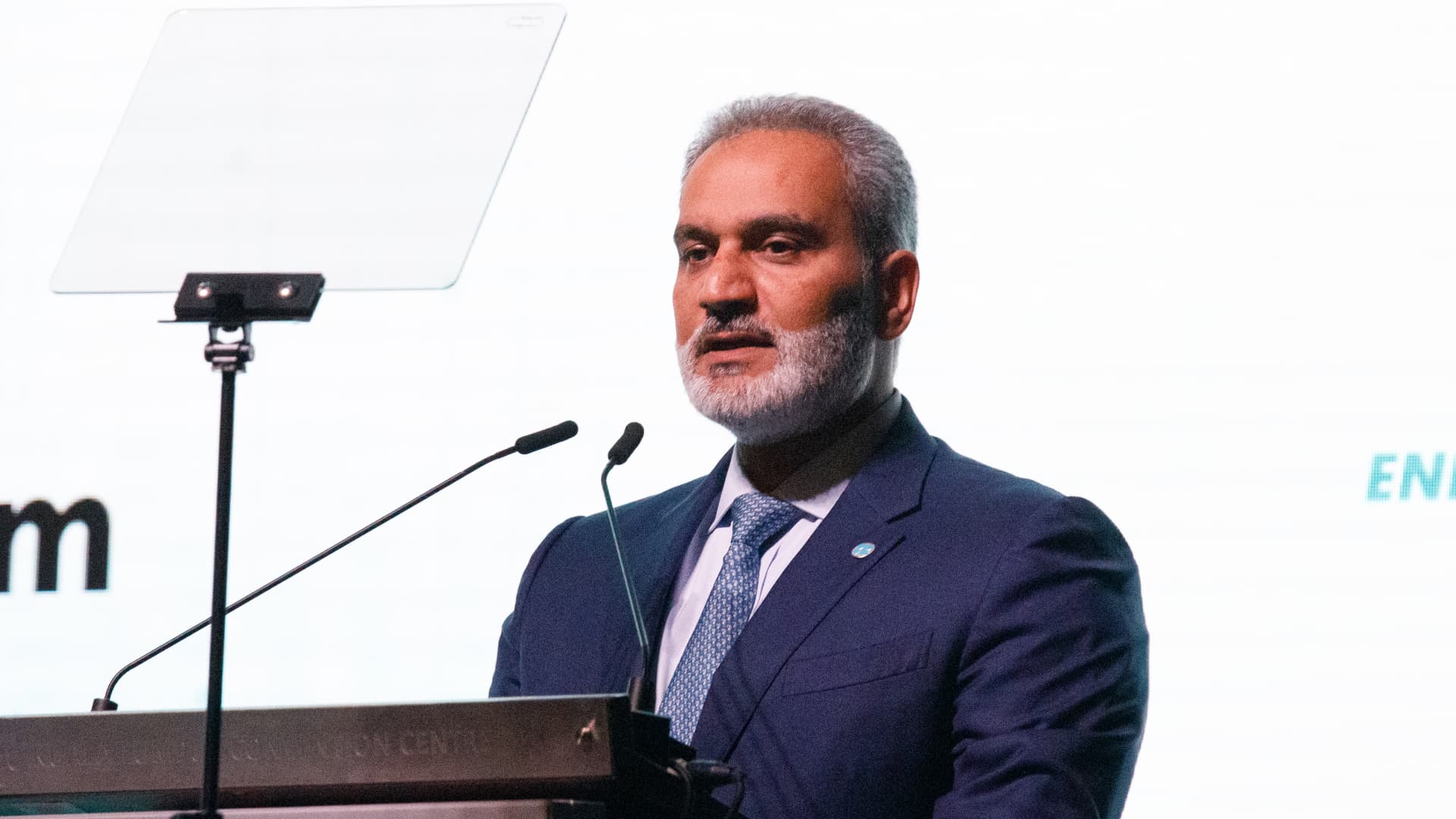
Haitham al-Ghais, secretary-general of the Organization of Petroleum Exporting Countries (OPEC), speaking at the Energy Asia Summit on June 26, 2023.
Bloomberg | Bloomberg | Getty Images
The secretary-general of the Organization of the Petroleum Exporting Countries signaled that the influential producers’ alliance is actively open to recruiting new members.
Asked if he is trying to expand the OPEC coalition, the organization’s Secretary-General Haitham al-Ghais told reporters on Wednesday: “I am, yes.”
The organization currently has 13 members, predominantly based in the Middle East, North and West Africa and South America. At stake for the group of oil producers is a battle to reconcile an outlook of tighter crude supply in the second half of the year, current macroeconomic worries, and inflationary concerns. OPEC members coordinate the amount of oil they output in an effort to influence prices.
Ecuador exited the group in 2020 because of political circumstances, but in May was invited to rejoin the OPEC ranks, according to a letter from al-Ghais shared by the Ecuadorian energy ministry.
“The Organization sees as a top priority that Ecuador joins the OPEC family again,” the letter said. The Ecuadorian ministry did not reveal its response.
Al-Ghais would not be drawn into disclosing the names of potential new members. He mentioned recent visits paid to oil-producing countries, however, including allies that currently implement a joint production strategy with OPEC countries, in a group known as OPEC+.
“I was in Malaysia, I was in Brunei,” he said, stressing that he had not necessarily invited these countries to join the organization. “I was in Azerbaijan, I was in Mexico.”
Previous speculation about Guyana’s potential membership saw OPEC state in late June that, while the South American country is “an emerging player in the international oil market with significant potential,” it had not been invited to join.
Asked about the requirements to become an OPEC member, al-Ghais said: “They have to be a net [oil] exporter, substantial, they have to have similar goals as OPEC. This is all mentioned very clearly in our statute. And I think many countries that I just named actually fit this profile. So … work in progress.”
Unanimity
The OPEC secretary-general addressed reporters following an OPEC seminar conference in Vienna, where energy and oil ministers met on the sidelines.
No new policies were announced, but ministers expressed appreciation for the additional oil production cuts of OPEC+ members Saudi Arabia, Russia and Algeria.
On Monday, Saudi Arabia announced that it would extend its voluntary 1-million-barrels-per-day cut initially outlined for July into August, while fellow heavyweight Moscow said it would trim its exports by 500,000 barrels per day next month. Algeria also said it will reduce its production by 20,000 barrels per day in August.
All three countries and several other OPEC+ members in April declared a separate set of output cuts totaling over 1.6 million barrels per day, which they have extended until the end of 2024.
Al-Ghais emphasized that the voluntary reductions enacted by some OPEC+ did not suggest divisions in the policy views of coalition members.
“When people can sit down and go through an agreement that goes all the way through, with a clear vision, into 2025, I think that’s a sign of unanimity,” he said.
“These are sovereign country decisions. They are extra. We appreciate them … It does not in any way insinuate that there is a fragmentation.”
Speaking to CNBC’s Dan Murphy on Thursday, al-Ghais underscored the ongoing uncertainty that continues to cast a deep shadow on the oil price landscape.
“There is a lot of ambiguity, I would say, in terms of some of the economic macro picture. [You] talk about banking issues in the U.S. You talk about recession fears, you talk about inflation still being dealt with. And I always want to remind people that we are not out of the woods in terms of Covid,” he said.
“The first half of the year, it hasn’t really panned out the way it was expected not only by OPEC, I would say, but by most. So we’re thinking that it could materialize in the second half of the year, with China opening up, maybe at a more rigorous rate than we’ve seen so far, [with] hopefully a settling of the economic conditions in the European and the U.S. systems.”
OPEC officials have in recent months flagged a disconnect between supply-demand fundamentals and global oil prices, which have absorbed the aftershocks of banking and economic turbulence since the start of the year.
On Thursday, Brent oil futures with September expiry were up 12 cents per barrel from the previous settlement, hitting $76.77 per barrel at 12:43 p.m. London time.
Focus on investment
Echoing the comments of other OPEC officials, al-Ghais has also been advocating for simultaneous joint investment in fossil fuel projects and in renewables, in an effort to avoid energy supply deficits. Despite what he perceives as global underinvestment in hydrocarbons, he said that the OPEC alliance can still answer any potential supply crisis.
“Part of the decision to reduce production is also good because it gives us more spare capacity, and OPEC has always managed to step up in case of any shock globally,” al-Ghais said.
“Spare capacity is tight, I would say … And our countries are investing. When I talk about underinvestment, most of our countries, if not all of them, are investing … But it’s a global responsibility. OPEC cannot shoulder this on its own. We have to have everybody step up.”

Suhail al-Mazrouei, energy minister of the United Arab Emirates, likewise stressed focus on investment and availabilities.
“What’s important is not the price, what’s important is the level of investments that are coming to the market to balance the longer or the medium-term view of the supply,” he told CNBC’s Dan Murphy on Wednesday. “If something worries me, that’s what worries me, the medium to long-term supply. Not the demand.”
The International Energy Agency in May foreshadowed an intense supply crunch, noting “tighter market balances we anticipate in the second half of the year, when demand is expected to eclipse supply by almost 2 mb/d.”




![Genesis GV60 Magma EV sheds camo, revealing a radical new look [Video]](https://i0.wp.com/electrek.co/wp-content/uploads/sites/3/2025/08/Genesis-GV60-Magma-EV-2.jpeg?resize=1200,628&quality=82&strip=all&ssl=1)






